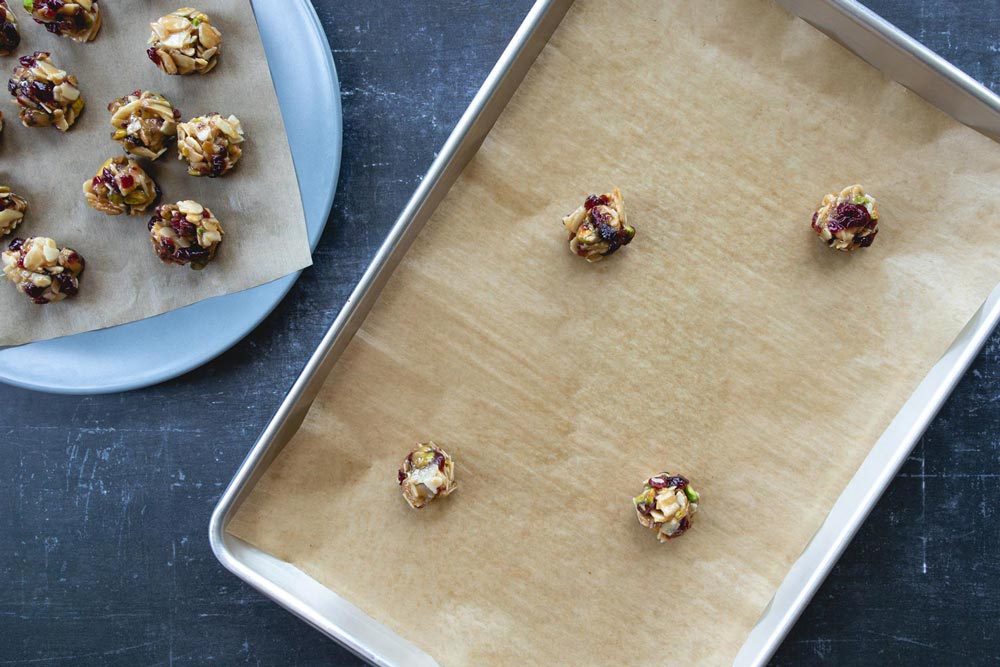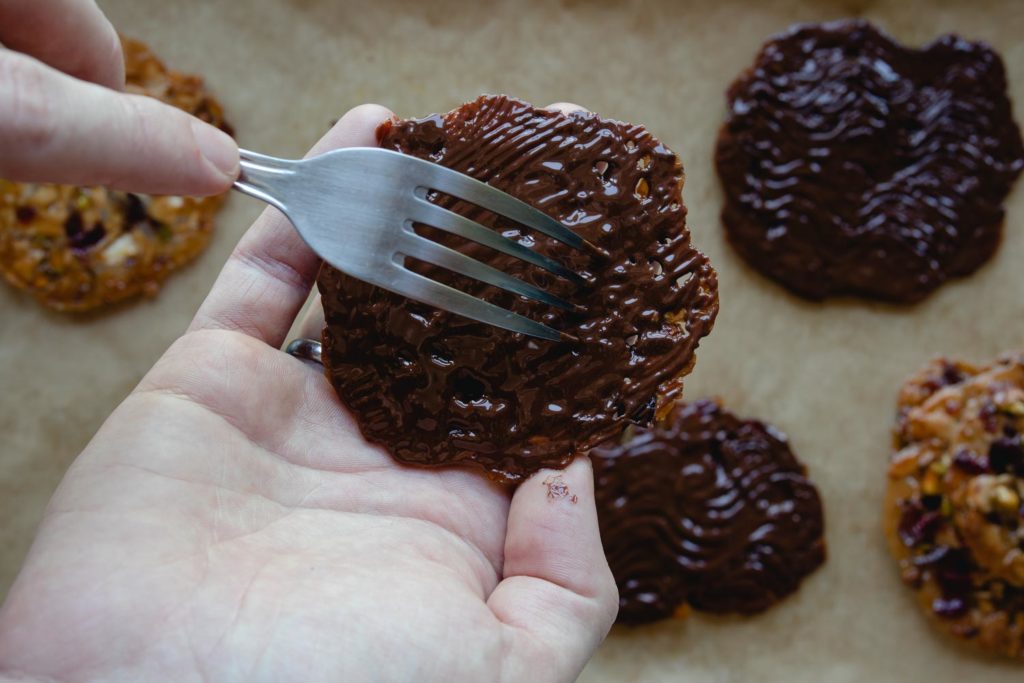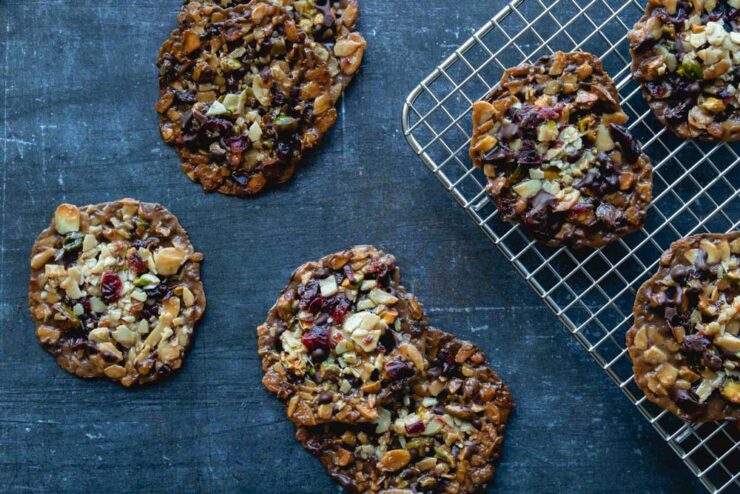Florentine biscuits are crisp, delicate cookies studded with toasted almonds, dried fruit and coated with dark chocolate. The batter is held together with caramel, so they are great for baking when you’re out of flour and eggs. Florentines are usually associated with the holiday season, but the nuts and dried fruit in the batter can be adjusted for any season. These biscuits are flavored for spring and summer with pistachios, cranberries and lemon zest.
The History of Florentine Biscuits
Despite their name, they do not actually originate in Florence, but in France. Looking at the ingredients, that may not be such a surprise. Cookies in Tuscany tend to be more substantial: think of cantuccini, amaretti or cavallucci. While most feature almonds, they aren’t nearly as delicate as the Florentine. Tuscan cookies mostly originate from the other towns around Florence, like Siena, Carmignano and Prato. Florence is better known for its breads and gelato.
I’ve found two legends of the Florentine’s origin. The first is that they were made by the pastry chefs at Versailles for King Louis XIV and his guests, the Medici family of Florence. The Medici family were relatives of the French royal family by Catherine de Medici, Queen Consort of France in the 16th century, and Marie de Medici Queen Consort of France in the early 17th century. The other legend is that they were created earlier during the reign of King Louis XII when a pastry chef for the Medici family came to visit and brought with him this recipe. So while we don’t know exactly when they were created, we do know that they were probably made in France and inspired by Florentine ingredients to honor the Medici family.
Tips for Making Florentine Biscuits
I like to make the batter ahead of time and let it cool before shaping the biscuits. I find it easier to portion and shape each biscuit this way, but it’s not necessary. You could use two teaspoons to portion the hot batter and bake directly after mixing. Florentines spread quite a bit while baking, so be sure to space each biscuit far apart. If they spread into each other and become one large sheet, you can use a round cookie cutter when they’re still warm and cut out separate cookies. Because they are made with caramel, they brown quickly in the oven. Keep an eye on them so they don’t burn. The biscuits harden as they cool, so let the biscuits cool on their baking sheet before moving them to a wire rack. Florentines are very delicate, so peel them gently from the parchment paper and handle them with care when coating with chocolate. The chocolate is not only there for flavor, but it also helps to keep the biscuits crisper for longer.
Ingredients:
Yields 18 biscuits.
50g granulated sugar
1 Tablespoon honey
1 Tablespoon double cream
55g sliced almonds
30g pistachios, roughly chopped
30g dried cranberries, roughly chopped
zest from 1 lemon
200g bittersweet chocolate (70%)
1/4 cup granulated sugar
1 Tablespoon honey
1 Tablespoon double cream
2/3 cup sliced almonds
1/3 cup pistachios, roughly chopped
1/4 cup dried cranberries, roughly chopped
zest from 1 lemon
7 ounces bittersweet chocolate (70%)
Make the caramel:
In a small heavy-bottomed sauce pan, melt the butter, sugar, honey and cream and bring to a boil.
Add the nuts:
Add the almonds and pistachios and continue to boil over medium heat for 2-3 minutes. Then remove the batter from the stove.
Add the cranberries and zest:
Add the dried cranberries and lemon zest to the batter and mix to combine.
Let the batter cool:
Leave the batter to rest until it is cool enough to work with. The caramel will firm up a bit, making it easier to portion evenly.
Preheat the oven:
Preheat the oven to 175°C (350°F).
Portion the biscuits:
Using your hands, divide the batter into 18 equal-sized balls of batter.

Bake the biscuits:
Place the balls of batter on a parchment-lined baking sheet. Leave plenty of room between each biscuit, they spread quite a lot. Flatten each biscuit with your fingers, then bake in the oven at 175°C (350°F) for 5-8 minutes.

They won’t harden in the oven, so you should judge them by the color. They have spread thinly and turned golden around the edges. Check after 5 minutes and keep a watchful eye on them. Because of the caramel, they quickly turn from perfectly golden to tragically burnt.
Cool the biscuits:
The biscuits harden as they cool, so let the biscuits cool on the baking sheet before moving them to a wire rack.

Melt the chocolate:
Once the biscuits are completely cool, set a up a bain-marie. Place a small saucepan filled with some water on the stove and set a glass or metal bowl over the saucepan without it touching the water below. Break the chocolate into pieces and place in the bowl, stirring gently until melted.
Coat the biscuits with chocolate:
Coat the underside of each biscuit with a thin layer of chocolate, either with a pastry brush or offset spatula. Use a fork to create the traditional wavy pattern. You probably won’t use all of the chocolate, but I find it easier to work with if there’s extra.
Put the chocolate-coated biscuits in the refrigerator to set the chocolate.




No Comments